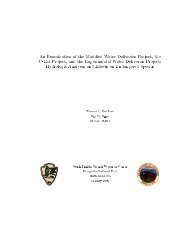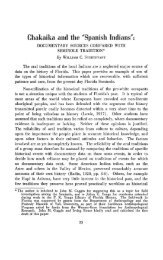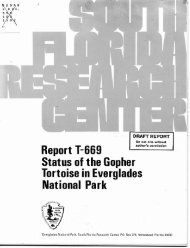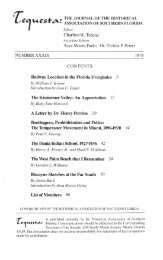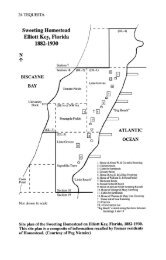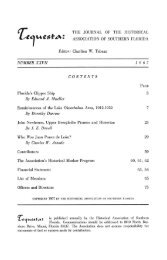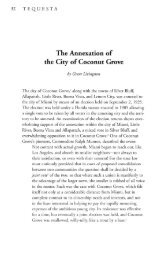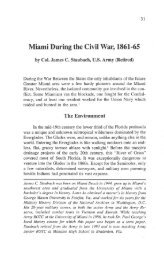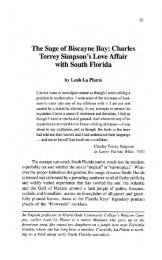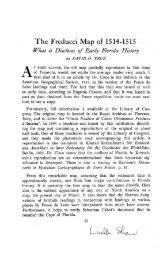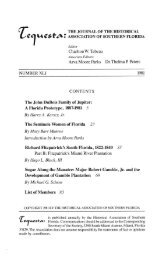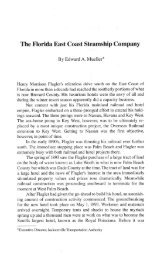The Coconut Grove Audubon Society, 1915-1917 - FIU Digital ...
The Coconut Grove Audubon Society, 1915-1917 - FIU Digital ...
The Coconut Grove Audubon Society, 1915-1917 - FIU Digital ...
Create successful ePaper yourself
Turn your PDF publications into a flip-book with our unique Google optimized e-Paper software.
Birds of a Feather:<br />
<strong>The</strong> <strong>Coconut</strong> <strong>Grove</strong> <strong>Audubon</strong> <strong>Society</strong>,<br />
<strong>1915</strong>-<strong>1917</strong><br />
By Emily Perry Dieterich<br />
Three Things to Remember<br />
A robin redbreast in a cage<br />
Puts all Heaven in a rage.<br />
A skylark wounded on the wing<br />
Doth make a cherub cease to sing.<br />
He who shall hurt the little wren<br />
Shall never be beloved by men.<br />
William Blake<br />
Organized bird protection in the United States began with the<br />
formation of the American Ornithological Union (AOU) in 1883.<br />
Addressing this specific concern, member William Brewster, curator<br />
of the Museum of Comparative Zoology at Harvard, moved to form<br />
a "Committee for the Protection of North American Birds" at the<br />
Union's annual meeting in 1884 (Robin Doughty, Feather Fashions<br />
and Bird Preservations: 157-58).<br />
<strong>The</strong> original <strong>Audubon</strong> <strong>Society</strong> was born several years later, the<br />
brainchild of the noted naturalist and outdoorsman, George Bird<br />
Grinnell, editor of Field andStream, the leading sportsmen's magazine<br />
of the time. Although a big game hunter himself, Grinnell was appalled<br />
by the slaughter of both game and non-game birds. "Gunners shot<br />
them for sport," he wrote, "small boys killed them for fun, and egg<br />
collectors robbed their nests." (Carl Buchheister and Frank Graham,<br />
"From the Swamps and Baclc" 7).<br />
While researching this story, Emily Perry Dieterich was director of environmental<br />
education for the Tropical <strong>Audubon</strong> <strong>Society</strong>. Currently she is the research<br />
historian for Metro-Dade Department of Historical Preservation.
6 TEQUESTA<br />
In February 1886 Grinnell suggested in a front page editorial<br />
of his magazine that "concerned men and women create an organization<br />
for the protection of wild birds and their eggs, its administration<br />
to be undertaken by the magazine's staff." Grinnell had grown up near<br />
the home of <strong>Audubon</strong> and even attended a school for young boys<br />
conducted by Lucy <strong>Audubon</strong>. <strong>The</strong> obvious name for his new organization<br />
was the <strong>Audubon</strong> <strong>Society</strong>.<br />
<strong>The</strong> public response to the <strong>Audubon</strong> <strong>Society</strong> was amazing.<br />
"Within a year nearly 39,000 men, women, and children had joined<br />
the society, signing pledges that they would not molest birds." (Buchheister<br />
and Graham: 7) After two years, however, the responsibility of<br />
running the society became too much for a magazine whose primary<br />
purpose was to entertain hunters and fishermen. Reluctantly, Grinnell<br />
abandoned the project.<br />
<strong>The</strong> AOU guided the bird protection movement for the next few<br />
years until February 1896 when Mrs. Augustus Hemenway of<br />
Boston called a meeting to form a Massachusetts <strong>Audubon</strong> <strong>Society</strong>.<br />
This group, which has been called "the ancestor of all of today's<br />
<strong>Audubon</strong> Societies" stated its purpose in its bylaws: "to discourage<br />
the buying and wearing, for ornamental purposes, of the feathers of<br />
any wild birds except ducks and gamebirds, and to otherwise further<br />
the protection of native birds." Several months later the qualifying<br />
phrase "except ducks and gamebirds" was stricken from the bylaws.<br />
<strong>The</strong> society's first president was William Brewster, the same man<br />
who had urged formation of the AOU's bird protection committee<br />
twelve years earlier. By the end of its first year, the Massachusetts<br />
<strong>Audubon</strong> <strong>Society</strong> had 1,284 members, 358 of whom were school<br />
children (Buchheister and Graham: 10).<br />
<strong>Audubon</strong> Societies were formed in other states almost immediately.<br />
<strong>The</strong> Pennsylvania <strong>Audubon</strong> <strong>Society</strong> was established later in<br />
the same year and by 1897 <strong>Audubon</strong> Societies were present in New<br />
York, New Hampshire, Illinois, Maine, Wisconsin, New Jersey, Rhode<br />
Island, Connecticut, and the District of Columbia. In 1898, Indiana,<br />
Ohio, Minnesota, Texas, California, and Tennessee formed societies<br />
making a total of seventeen by the end of 1898.<br />
In 1899 Frank M. Chapman, author and ornithologist in the<br />
American Museum of Natural History, founded the magazine Bird<br />
Lore, which would one day evolve into the popular <strong>Audubon</strong> Magazine.<br />
This publication was accepted as the official organ of the various<br />
state <strong>Audubon</strong> societies. Some twelve years earlier Chapman had
<strong>Coconut</strong> <strong>Grove</strong> <strong>Audubon</strong> <strong>Society</strong> 7<br />
spent time in Florida, near Gainesville, exploring the Indian and<br />
Sebastian Rivers and writing a description of birds on Pelican Island.<br />
"Save the wild birds of Florida" was the call of the pioneers who<br />
formed the Florida <strong>Audubon</strong> <strong>Society</strong> (FAS) in 1900. Fifteen people<br />
were present at the first meeting held at the winter home of Louis F.<br />
Dommerich, a wealthy textile manufacturer from New York. Dues<br />
for the FAS were $1 for regular members, $5 for sustaining members,<br />
and $25 for patrons. No membership dues were required of teachers,<br />
and junior members paid 25 cents a year. <strong>The</strong> first president of the<br />
FAS was Reverend H.B. Whipple, a retired Episcopal Bishop from<br />
Minnesota, who served for one year and was succeeded by Dommerich<br />
who presided from 1901 to 1912.<br />
Distinguished members and patrons of the FAS included Henry<br />
M. Flagler, Mrs. Edward Bok, and Thomas A. Edison. Among the<br />
honorary vice presidents were President <strong>The</strong>odore Roosevelt, former<br />
President <strong>Grove</strong>r Cleveland, former Governor W.D. Bloxham,<br />
Governor W.S. Jennings and Kirk Munroe. Munroe was a wellknown<br />
author of boys' adventure stories and was once voted the most<br />
popular author of children's stories in America. He was active in the<br />
Boy Scouts and had traveled extensively throughout Florida and the<br />
world. Munroe had lived with his wife, Mary Barr Munroe, daughter<br />
of the famous novelist Amelia Barr, in <strong>Coconut</strong> <strong>Grove</strong> since 1885.<br />
Bird protection received an important lift on the national level<br />
with the passage on May 25, 1900, of the Lacey Act, sponsored by<br />
Representative John F. Lacey of Iowa. <strong>The</strong> law "prohibited the<br />
interstate traffic in birds and animals killed in violation of state laws,<br />
as well as the importation of alien species (such as the starling and the<br />
English sparrow), without government permits" (Buchheister and<br />
Graham: 13). <strong>The</strong> Lacey Act was just a beginning, however, as it applied<br />
only to the five states which had protective laws of their own.<br />
Florida passed its law in 1901 with the help of the FAS. Entitled<br />
"An act for the protection of birds and their nests and eggs and prescribing<br />
a penalty for any violation thereof," it was the first law Florida<br />
had ever considered concerning the protection of non-game birds.<br />
<strong>The</strong> legislature passed the bill "with reservations," meaning that<br />
hawks, crows, owls, shore birds, ducks, pigeons, butcher birds<br />
(shrikes), meadow larks, robins, and rice birds (bob-o-links) were<br />
still on the game list. Anyone violating the law was guilty of a misdemeanor<br />
and was "liable to a fine of five dollars for each offense, and<br />
an additional fine of five dollars for each bird, living or dead, or part
8 TEQUESTA<br />
of a bird, or nest or eggs possessed in violation of this act, or to imprisonment<br />
for ten days, or both at the discretion of the court" (Laws<br />
of Florida 1901:102).<br />
Of interest is Section 8 of the act which read:<br />
Nothing in this act shall prevent any citizen of the State of Florida from<br />
destroying birds which are found injuring grapes, fruits, garden or farm<br />
products on his premises, or from taking or keeping in a cage any cardinal,<br />
redbird or mocking bird for his own pleasure or amusement: Provided,<br />
that the same shall not be sold or shipped out of the State. (Laws of<br />
Florida 1901:103).<br />
Another law as passed in 1901, specifically referring to Dade<br />
County, which was called, "An Act prohibiting killing, capturing or<br />
shooting any deer, crocodile, water-fowl or any wild bird (except<br />
crows), within one mile of the incorporated town of West Palm Beach,<br />
Florida." Punishment for violation of this law was a fine "not exceeding<br />
one hundred dollars nor less than ten dollars, or by imprisonment<br />
not exceeding ninety days nor less than ten days" (Laws of Florida<br />
1901:101).<br />
<strong>The</strong> Lacey Act spurred the movement of a national orientation<br />
for the various state <strong>Audubon</strong> Societies. In November 1901, the<br />
representatives of the existing societies met in New York City and<br />
agreed to create a loose federation called the National Committee<br />
of <strong>Audubon</strong> Societies. Each state society retained its individual<br />
identity rather than merging into a national organization. New York<br />
City was designated as the committee's headquarters and William<br />
Dutcher, former chairman of the AOU's Bird Protection Committee,<br />
was elected chairman. Dutcher recruited T. Gilbert Pearson, who<br />
had grown up in Florida, had formed the North Carolina <strong>Audubon</strong><br />
<strong>Society</strong>, and was known as a zealous bird protector. Together they<br />
worked for passage of more individual state laws and the creation<br />
of a game warden system.<br />
<strong>The</strong> FAS incorporated soon after this in June 1902, with its<br />
stated purpose to:<br />
disseminate information respecting the economic value of birds to<br />
agriculture, and their importance to the welfare of man, thereby preventing<br />
the wanton destruction of wild birds and their eggs. As many<br />
birds emigrate from the north to the south in the winter months, the<br />
Florida <strong>Audubon</strong> <strong>Society</strong> is of particular importance. To discourage<br />
the purchase or use of the feathers of any birds for ornamentation, except<br />
those of the ostrich and domesticated fowls. To establish Bird Day
<strong>Coconut</strong> <strong>Grove</strong> <strong>Audubon</strong> <strong>Society</strong> 9<br />
exercises and to encourage the introduction of bird study in the schools<br />
of the State (Lucy W. Blackman, "<strong>The</strong> Florida <strong>Audubon</strong> <strong>Society</strong>:"l 1).<br />
In the past, as in the present, the national organization of <strong>Audubon</strong><br />
societies was interested in Florida because of the many nesting<br />
grounds for plumage birds. As early as the turn of the century, William<br />
Dutcher tried to buy Florida's Pelican Island in the Indian River<br />
from the federal government to protect an important breeding rookery<br />
of brown pelicans. <strong>The</strong> project became bogged down in bureaucratic<br />
red tape, but President <strong>The</strong>odore Roosevelt was so impressed by<br />
Dutcher's scheme that he took matters into his own hands and set the<br />
island aside as the first National Wildlife Refuge. <strong>The</strong> Executive Order<br />
was signed March 14, 1903. <strong>The</strong> fact that President Roosevelt was a<br />
charter member of the FAS undoubtedly helped the situation.<br />
<strong>The</strong> FAS was active in the business of educating school children<br />
about birds. One of the ten leaflets written for the society between 1901<br />
and 1909 was by Kirk Munroe, entitled Florida Birds Worth <strong>The</strong>ir<br />
Weight in Gold. Mr. Munroe described the economic importance of<br />
birds in Florida with respect to the eating of insects which damaged<br />
the state's crops and fruit groves. He also mentioned the novel idea<br />
of birds as a tourist attraction. In his concluding paragraph he wrote,<br />
We take every precaution to prevent a thief from stealing even the most<br />
trifling of our possessions, and at the same time make no effort to dissuade<br />
the gunner from shooting the birds upon whose existence depends our<br />
very livelihood. Queer, isn't it?<br />
<strong>The</strong> Thayer Fund, which was organized by the prominent landscape<br />
and portrait painter, Abbot H. Thayer, had been established<br />
in 1900 to protect bird colonies. <strong>The</strong> fund also provided financial<br />
support for the warden system. By 1904 the fund was paying for<br />
thirty-four wardens in ten states, including Florida (Buchheister and<br />
Graham: 13). Four of these wardens were working in Florida and one<br />
may have been Guy Bradley, who patrolled the South Florida coast<br />
and mangrove jungles.<br />
Bradley was recommended by Kirk Munroe who said that he<br />
was "fearless and brave and had an extensive knowledge of the<br />
country and the birds that lived there . . . always alert and faithful<br />
in the performance of his duty, and was willing to undergo any hardship<br />
to protect the birds." Tragically, Bradley was killed while making<br />
an arrest at a rookery on Oyster Key. <strong>The</strong> National Committee<br />
received hundreds of contributions to pay for a new home for Bradley's
10 TEQUESTA<br />
widow and children in Key West. William Dutcher wrote, "Every<br />
great movement must have its martyrs, and Guy Bradley is the first<br />
martyr in the cause of bird protection."<br />
In January 1905 thirty-five state <strong>Audubon</strong> societies filed incorporation<br />
papers in New York under a new name, the National<br />
Association of <strong>Audubon</strong> Societies for the Protection of Wild Birds<br />
and Animals. (<strong>The</strong> name was not changed to the current National<br />
<strong>Audubon</strong> <strong>Society</strong> until 1940). Dutcher was elected president and<br />
Pearson was elected secretary of the association.<br />
<strong>The</strong> bird protection movement actually began in Dade County<br />
as early as 1906 when Mary Barr Munroe organized "a little club of<br />
boys whom she called the Bird Defenders, and who loyally rallied<br />
to her support in the protection of their little feathered friends"<br />
(Lucy w. Blackman, <strong>The</strong> Women of Florida: 145). Blackman may<br />
be referring to "<strong>The</strong> <strong>Coconut</strong> <strong>Grove</strong> Rangers," as described and<br />
pictured in the May <strong>1915</strong> issue of Tropic Magazine which reported<br />
that it was a "bird club founded in 1906 that did good work in bird<br />
protection for four years."<br />
By 1912 the FAS had 1,500 members and in 1913 Mary Barr<br />
Munroe was elected to the executive committee. Also in 1913 two<br />
important state laws were passed: "An act to protect game and birds<br />
in the state of Florida" and "An act creating a Department of Game<br />
and Fish of the state of Florida and creating the Office of State Game<br />
and Fish Commissioner." <strong>The</strong> former defined game birds identical<br />
to the 1901 law but omitted pigeons and robins from the list. It also<br />
prohibited certain methods of capture, outlawed night hunting, and<br />
established hunting seasons and licenses. <strong>The</strong> latter law was created<br />
to enforce the former one and to prosecute its violators, issue licenses<br />
and collect fees.<br />
<strong>The</strong> year 1913 saw much progress at the national level as well.<br />
According to Blackman, "In Washington the greatest campaign on<br />
behalf of bird protection ever put on in any country was in full force<br />
in the Congress." <strong>The</strong> Federal Migratory Bird Law was signed by<br />
President Taft in March and was designed to put all game birds that<br />
do not remain permanently within the borders of any state or territory<br />
under the jurisdiction of the federal government. Another important<br />
law was actually a clause, tacked onto a tariff bill, which halted the<br />
importation of wild bird plumage into the United States.<br />
Between 1913 and <strong>1915</strong> bird protection claimed a significant<br />
victory. According to Todd Persons, "<strong>The</strong> bottom dropped out of the
<strong>Coconut</strong> <strong>Grove</strong> <strong>Audubon</strong> <strong>Society</strong> 11<br />
international plumage market. Feather merchants had been plucked<br />
by their own greed and by fickle dame fashion." Unfortunately, before<br />
the FAS even had time to celebrate, "the Florida legislature, satisfied<br />
that state legislation was no longer needed, repealed the plumage<br />
laws and a number of valuable hunting laws with them. <strong>The</strong> slaughter<br />
was renewed . . . "(Todd Persons, <strong>The</strong> First One Hundred Years:6).<br />
It was amid these problems that the first official <strong>Audubon</strong> <strong>Society</strong> was<br />
established in Dade County in <strong>1915</strong>.<br />
<strong>The</strong> first meeting of the <strong>Coconut</strong> <strong>Grove</strong> <strong>Audubon</strong> <strong>Society</strong><br />
(CGAS) was held on April 16, <strong>1915</strong> in the public school auditorium<br />
of <strong>Coconut</strong> <strong>Grove</strong>. "By reason of his authority as one of the state vice<br />
presidents, Mr. Kirk Munroe called the meeting to order and made<br />
a few remarks about the need of such a society in <strong>Coconut</strong> <strong>Grove</strong>"<br />
(CGAS Minutes, 4/16/<strong>1915</strong>). Given the active involvement of the<br />
Munroes in the FAS, it is somewhat surprising that such an organization<br />
was not formed sooner than fifteen years after the FAS had been<br />
established. Nonetheless, the society was soon to become one of the<br />
most vocal and active in the state. Mary Barr Munroe was elected to<br />
the office of president, Mrs. Schober was vice president, Mrs. Florence<br />
P. Haden was secretary, and Mrs. H.K.B. Davis served as treasurer.<br />
Mrs. Haden was the wife of Captain John M. Haden, a Civil<br />
War veteran, who retired and moved to <strong>Coconut</strong> <strong>Grove</strong> in 1896. He<br />
purchased thirteen acres near Douglas Road and Ingraham Highway.<br />
<strong>The</strong> property soon became known as "Haden's Corner." It was also<br />
often referred to as "Mango Lodge," as Captain Haden became very<br />
interested in growing mangoes. He planted a Mulgoba mango in 1898,<br />
and in 1910 one tree bore the distinctive large yellow and red mango<br />
known today as the Haden mango. Although Captain Haden died<br />
shortly thereafter, Mrs. Haden marketed the mango, and groves were<br />
planted all over the area. This variety of mango was very important<br />
in the development of a marketable mango (Arva Moore Parks, <strong>The</strong><br />
History of <strong>Coconut</strong> <strong>Grove</strong>, Florida, 1821-1925:47). Mrs. Haden was<br />
also involved with the Housekeepers Club, a womens' club established<br />
in 1891. Her contribution to the club's cookbook was appropriately<br />
a recipe for mango chutney.<br />
Membership dues for the CGAS were 50 cents a year plus a 10 cents<br />
initiation fee to cover the cost of an <strong>Audubon</strong> button. Kirk Munroe<br />
is recorded as the first person to pay his dues. A life membership cost<br />
$25. Mrs. Munroe announced at the first meeting that she had secured<br />
two life members: Charles Deering and W.J. Matheson. Charles
12 TEQUESTA<br />
Deering was the son of William Deering of International Harvester<br />
fame who settled in <strong>Coconut</strong> <strong>Grove</strong> in 1902. Charles lived on an estate<br />
in the Buena Vista area and raised water birds. He bought lots in Cutler<br />
and in 1916 bought the Richmond Cottage on the old Perrine Grant.<br />
(<strong>The</strong> property is now known as the Deering Estate and was recently<br />
acquired by Dade County and the State of Florida.) Charles's<br />
brother, James, also a member of CGAS, built the exquisite<br />
mansion, Vizcaya, on Biscayne Bay in 1916.<br />
Mr. Matheson was one of the first millionaires to build a home<br />
in <strong>Coconut</strong> <strong>Grove</strong> and, together with his sons Hugh and Malcolm,<br />
built three houses on the bayfront, the first being "Four Way Lodge"<br />
on present-day Poinciana Avenue (Parks:53). Hugh later served two<br />
terms as mayor of <strong>Coconut</strong> <strong>Grove</strong> from 1921-1923.<br />
Teachers, it was announced at the first meeting, would be associate<br />
members and were exempt from dues. Apparently this didn't apply to<br />
school administrators, however, as the minutes indicate Mr. J.W.<br />
Asbury, principal of the <strong>Coconut</strong> <strong>Grove</strong> School, and his wife paid<br />
their dues at the second meeting of the society, making them charter<br />
members.<br />
At the fourth meeting of the society Mrs. Munroe explained that<br />
the first thirty people who had joined would be referred to as"founders"<br />
and would have <strong>Audubon</strong> buttons presented to them by a "friend of<br />
the society." <strong>The</strong> following is a list of the founders of the CGAS:<br />
Mr. and Mrs. Kirk Munroe<br />
Mr. and Mrs. W. J. Matheson<br />
Mr. and Mrs. Hugh Matheson<br />
Mr. Charles Deering<br />
Mr. and Mrs. Asbury<br />
Mr. and Mrs. Mather<br />
Mrs. John Gifford<br />
Mrs. Florence Haden<br />
Mrs. H.K.B. Davis<br />
Mrs. Schober<br />
Mrs. Woolley<br />
Mrs. Kilbourne<br />
Mr. and Mrs. Little<br />
Miss Olive Callahan<br />
Miss Wallin<br />
Miss Dunham<br />
Mrs. Church<br />
Mrs. Stewart<br />
Mrs. Moore<br />
Miss Dock<br />
Mrs. Charles T. Simpson<br />
Miss Hart<br />
Miss Root<br />
Miss Mary Callahan<br />
Mrs. Richardson<br />
A problem concerning men being members arose when the society<br />
decided to join the National Federation of Womens Clubs. Since men
<strong>Coconut</strong> <strong>Grove</strong> <strong>Audubon</strong> <strong>Society</strong> 13<br />
could not belong to the federation, the alternative of making them<br />
honorary members was discussed. At a meeting in November <strong>1915</strong> the<br />
president announced that the CGAS had become a member of the<br />
state <strong>Audubon</strong> <strong>Society</strong> but it had not joined the National Federation<br />
which would have disbarred the men members. <strong>The</strong> society also decided<br />
to join the National Association of <strong>Audubon</strong> Societies at the same<br />
meeting.<br />
Mrs. Arthur Curtis James became the third life member of the<br />
society, paying her $25 dues at the November 1, <strong>1915</strong> meeting. Her<br />
husband, reported to be the second richest man in America at the time,<br />
later purchased "Four Way Lodge" and contributed the major portion<br />
of money to finance the building of Plymouth Church (Parks:54).<br />
At the August 7, 1916 meeting, Mrs. Munroe proposed that<br />
William Dutcher, past president of the National Association of<br />
<strong>Audubon</strong> Societies, be made an honorary life member of the CGAS.<br />
A letter from Dutcher was read at the September meeting accepting<br />
this kind offer.<br />
<strong>The</strong> treasurer's ledger indicates forty-one members for the year<br />
<strong>1915</strong>-1916, classified as seven men, twenty-three married women,<br />
and eleven single women. Ninety-eight members were recorded for<br />
1916-<strong>1917</strong>, which included separate entries for husbands and wives.<br />
<strong>The</strong> society held seven meetings during <strong>1915</strong>, the first board<br />
meeting being on August 28, <strong>1915</strong>. <strong>The</strong> first two meetings were held<br />
in the public school auditorium of <strong>Coconut</strong> <strong>Grove</strong>. <strong>The</strong>reafter, most<br />
meetings were held at members' residences. Throughout the years<br />
the secretaries provided colorful accounts of the various meeting<br />
places, consistently noting the name, place and sometimes even the<br />
hour and minute of the meeting. Five meetings were held at Mrs.<br />
Munroe's house, "<strong>The</strong> Scrububs," and one at Mrs. Haden's "Mango<br />
Lodge." One meeting took place at the "beautiful home of Mrs. Thomas<br />
Wyatt in 'Ye Little Woods'," one at the "pleasant home of Mrs. J.<br />
Edward Howard," and yet another at"the beautiful home of Mrs. N.L.<br />
Stevenson on <strong>Coconut</strong> <strong>Grove</strong> Ridge." <strong>The</strong> March, 1916 meeting was<br />
held at,<br />
the beautiful home of Mrs. Hugh Matheson . . . It would be hard to do<br />
justice to a description of the terrace with its setting of plants, the tall pines<br />
on the lawn with the water in the distance showing through the oleanders.<br />
<strong>The</strong> weather was perfect for an out of door party and those present will<br />
not soon forget the charming picture the large number of visitors and<br />
members made (CGAS minutes, 3/6/1916).
14 TEQUESTA<br />
<strong>The</strong> society went to Little River in April 1916 where a meeting<br />
was held at the home of Mr. and Mrs. Charles T. Simpson, he the noted<br />
naturalist and botanist:<br />
After the meeting the party was asked to visit Professor Simpson's<br />
wonderful hammock,'Simpson's Tangle,' which proved most interesting.<br />
<strong>The</strong> Tangle is located on the shore of Biscayne Bay, in a dense<br />
hammock. Professor Simpson has carefully guarded the native trees,<br />
built walks and placed seats . . . also introduced many very rare<br />
shrubs and plants, many of which were in full bloom. Among the rare<br />
plants there are none more rare than the orchids. Of these Professor<br />
Simpson has a great number of the choicest and most rare orchids<br />
grown in any part of the world. <strong>The</strong> visit to the Tangle added much<br />
pleasure to the meeting (CGAS minutes, 4/9/1916).<br />
With few exceptions every meeting was opened with a bird poem,<br />
"a special one chosen for the day," read by Mrs. Kilbourne, who was<br />
officially appointed as "<strong>Society</strong> Poet" in June <strong>1915</strong>. Many well known<br />
poems by famous authors were read including Wordsworth's "Ode to<br />
the Skylark," Vandyke's "<strong>The</strong> Goodluck Bird," and William Cullen<br />
Bryant's "To a Waterfowl." <strong>The</strong> poetry reading was billed as a "feature<br />
of the meetings" and a newspaper article dated January 13, 1916, gives<br />
the following account: "Of course the meeting was opened with the<br />
reading of a bird poem by Mrs. Kilbourne and this time it was a lovely<br />
bit of bluebird verse. That made us all rejoice."<br />
<strong>The</strong> treasurer's report was read at every meeting but rarely included<br />
actual dollar figures. <strong>The</strong> minutes of the November <strong>1915</strong> meeting<br />
indicate a balance of $87.47 in the treasury. <strong>The</strong> treasurer's ledger<br />
reflects $57.40 as of March 1916, which grew to $174.09 by May 1916.<br />
<strong>The</strong> society was primarily financed by members' dues. Of note,<br />
however, is a series of contributions by Charles Deering totaling $300<br />
in donations, over a six-year period. This amount was in addition to<br />
the initial $25 fee for his life membership. <strong>The</strong> only mention of any of<br />
these donations occurred at the February 5, <strong>1917</strong> meeting when Mrs.<br />
Munroe "reported several gifts, one of which was a check from Mr.<br />
Charles Deering for $50 which he called his modest contribution to the<br />
society."<br />
Other less substantial monetary donations to the society included<br />
one from the <strong>Coconut</strong> <strong>Grove</strong> Rangers:<br />
S. .at the last meeting of the Rangers it was decided to give the money<br />
belonging to the organization to Mrs. Kirk Munroe, to use in some way<br />
for the birds. This money was only a part of the original sum of eleven<br />
dollars left after the Miami Bank failure, from which every society in the<br />
county suffered loss. So now after five years it has been decided to give this
<strong>Coconut</strong> <strong>Grove</strong> <strong>Audubon</strong> <strong>Society</strong> 15<br />
money in cash prizes to the <strong>Coconut</strong> <strong>Grove</strong> school children for bird work<br />
(Tropic, <strong>1915</strong>:33).<br />
Another children's club also made a donation to the society:<br />
Mrs. Archer announced that her girls' club, "<strong>The</strong> Jenny Wrens" which<br />
disbanded three years ago had voted to donate the money left in the<br />
treasury, nearly $1.00, to the <strong>Audubon</strong> <strong>Society</strong>. Same was accepted with<br />
thanks to Mrs. Archer (CGAS Minutes, 10/4/<strong>1915</strong>).<br />
Many donataions of a non-monetary nature were made to the<br />
society including books, bird charts, and the <strong>Audubon</strong> buttons from<br />
an anonymous donor. Mrs. Charles Boyd of East Walpole, Massachusetts,<br />
donated three bird charts and a book on water birds to the society<br />
at the June 7, <strong>1915</strong> meeting. Mrs. Bancroft Davis of Boston donated a<br />
Brownie camera to be given as a prize to school children, and Mrs.<br />
Gifford donated two books and a calendar. Mr. Deering sent another<br />
donation for supplies and "a vote of thanks was given Mr. Deering for<br />
the many helps to the society, including stationary printed, stamps, etc."<br />
<strong>The</strong> minutes and ledger indicate that regular expenditures were<br />
made on printing and stationary, ($19.15), postal cards, ($2), and<br />
stamps, (10 cents). Payment of $5 in dues to the FAS and to the National<br />
Association is also recorded in the ledger.<br />
<strong>The</strong> society made contributions to other organizations such as<br />
$5 to the Red Cross. When the society gave $5 to the Humane <strong>Society</strong> it<br />
asked "that the officer do what he could for the protection of birds and<br />
send a report of what he had done"(CGAS Minutes, 6/7/<strong>1915</strong>).<br />
<strong>The</strong> meetings did not regularly include any program, in the entertainment<br />
sense of the word, such as guest speakers or slide shows.<br />
Several special programs are worth mentioning however. <strong>The</strong> May 1916<br />
meeting "was brought to a close by a very clever recitation in French<br />
about birds given by Miss Alice Crawford." Miss Crawford also performed<br />
at the December 6, 1916 meeting with "a whistling tune" and<br />
again at the April 2, <strong>1917</strong> meeting at which time she "very cleverly<br />
imitated the notes of the wren, bob white, and the cardinal."<br />
Another "entertainer" was Miss Isabell Goodhue who attended<br />
the first annual meeting of the CGAS. According to a news article<br />
from March 1916,<br />
S. a little lady stepped out from behind the palms dressed in a gown<br />
of greens and browns made especially for out of door walking and which<br />
she calls her field dress and was introduced by Kirk Munroe . . . as the<br />
Florida <strong>Audubon</strong>'s field agent. Miss Goodhue gave a charming talk on<br />
birds and delighted everyone by her clever imitation of bird notes and calls.
16 TEQUESTA<br />
Miss Goodhue performed again at the second annual meeting<br />
when she read "her stirring appeal for the birds, describing her trip<br />
across the continent lecturing on the importance of conserving bird life.<br />
Her imitation of bird notes and songs are truly wonderful" (CGAS<br />
minutes, 3/3/<strong>1917</strong>). <strong>The</strong> treasurer's ledger indicates a payment of $15<br />
to Miss Goodhue on March 5, <strong>1917</strong>.<br />
A "special bird musical meeting" was held on June 21, <strong>1915</strong>:<br />
.. the members of the CGAS were invited to gather at Mrs. John<br />
Gifford's and enjoy listening to a set of bird music records, given by<br />
Kellogg the bird song man . . . After the records were finished Mrs.<br />
Gifford and Miss Andrus played the first two parts of Beethoven's<br />
Pastoral Symphony . . . in which occur the notes of the Wren, Yellow<br />
Hammer, Lark, Dove, and Cuckoo. It is needless to say how delightful it<br />
all was (Tropic, <strong>1915</strong>:28).<br />
<strong>The</strong> majority of the meetings were business-oriented, however,<br />
with many discussions, letter readings and papers. <strong>The</strong> following is a<br />
list of the papers for the year <strong>1915</strong>-1916:<br />
Mrs. Charles T. Simpson, "Historical Sketch of <strong>Audubon</strong> Societies"<br />
Mrs. Wyatt, "Bird Reservations of the United States"<br />
Mrs. H.K.B. Davis, "Bird Sanctuaries and How to Make <strong>The</strong>m"<br />
Mrs. R.L. Stewart, "Land Birds of Florida"<br />
Mrs. Florence P. Haden, "Economic Value of Birds"<br />
A March 1916 news article reported that "these papers are so<br />
interesting and full of valuable material that they have been entered<br />
among the papers of the Florida Federation of Womens Club Bureau<br />
of Information, so that club women of the state may have the benefit<br />
of the knowledge they contain."<br />
<strong>The</strong> meetings always concluded with a social hour. Here again<br />
the secretaries chose to record for posterity every detail of the hostesses'<br />
house and refreshments. <strong>The</strong> January 3, 1916 meeting adjourned and<br />
"all enjoyed the tea and cake served by Mrs. Munroe in her usual<br />
gracious manner." At the May meeting of the same year, Mrs. Kilbourne,<br />
"the hostess of the day," served "dainty refreshments she had<br />
prepared for her guests." As a special treat in January <strong>1917</strong>, "the guests<br />
were given the very charming little bird cards painted in watercolors by<br />
Mrs. Wade, and Mrs. Munroe served tea, chocolate and much<br />
delicious cake."<br />
Education has always been a primary concern of <strong>Audubon</strong><br />
Societies at the national, state, and local levels. At the very first meeting<br />
of the CGAS, Kirk Munroe stated, "the school children have been
<strong>Coconut</strong> <strong>Grove</strong> <strong>Audubon</strong> <strong>Society</strong> 17<br />
pretty well instructed in bird lore, but . . . there is need of instruction<br />
about the value of birds in the community" (CGAS minutes,<br />
4/16/<strong>1915</strong>).<br />
<strong>The</strong> society wasted no time in beginning their work. At the second<br />
meeting Mrs. Davis reported a plan for work in "colored town and she<br />
suggested that we form a bird society for the colored boys and have<br />
them pay a small fee of 10 cents and pledge themselves not to kill birds<br />
but to protect them and that they be given some sort of badge" (CGAS<br />
minutes, 5/3/<strong>1915</strong>). At the meeting in June, Mrs. Munroe outlined the<br />
work the society proposed to do in schools that season, "not only in<br />
our public schools but in the colored public schools as well." Mrs.<br />
Munroe called for volunteers for the "school work" and Mrs. Gifford,<br />
Mrs. Schober, Mrs. Haden, Mrs. Heso and Mrs. Hugh Matheson<br />
"responded cheerfully."<br />
A board meeting was called by the president on August 28, <strong>1915</strong><br />
specifically to plan the work in schools for the fall:<br />
It was decided to begin work at St. Albans and the colored school on the<br />
15th of October by addressing the schools and presenting the materials<br />
to work with. A prize will be given to both schools. <strong>The</strong> St. Albans school<br />
children will be allowed to wear the robin button, the children to pay for<br />
them. Two prizes will be offered, one to the girls and one to the boys for<br />
the best poem written about the mocking bird. One prize will be offered to<br />
the boys for the best imitation made of the mocking bird whistle or call.<br />
Both prizes will be worth working for and will be awarded at the annual<br />
meeting of the CGAS (CGAS minutes, 8/28/<strong>1915</strong>).<br />
<strong>The</strong> ladies began their work that fall and at the November <strong>1915</strong><br />
meeting,<br />
Full and interesting reports were read concerning the visits to St. Albans<br />
school and the <strong>Coconut</strong> <strong>Grove</strong> colored school. Mrs. Munroe said the<br />
St. Albans class was called the robin class and the class in the colored public<br />
school the red-headed woodpecker class. She reported great enthusiasm<br />
on the part of the pupils and trusted that the work would be of lasting<br />
benefit . . . the last day of each month in both schools was to be<br />
designated as <strong>Audubon</strong> Day (CGAS Minutes, 11/1/<strong>1915</strong>).<br />
Special thanks were given to Mr. J.W. Asbury, the principal of the<br />
<strong>Coconut</strong> <strong>Grove</strong> school and a charter member of the society,<br />
for his interest shown in the work, and the thoughtful arrangements made<br />
for doing it. In fact, Nature Study in the <strong>Coconut</strong> <strong>Grove</strong> School is one of<br />
the taking features, and makes study of all kinds more pleasant for Mr.<br />
Asbury's pupils (Tropic, <strong>1915</strong>:33).<br />
<strong>The</strong> treasurer's ledger indicates many expenditures for educationrelated<br />
items including "book for school teacher, $2.00", "colored plates
18 TEQUESTA<br />
for public school children, 70c", "6 prizes for schools, $5.10", "1 dozen<br />
bird primers, $1.50", and "Bird Notebooks, $8.00."<br />
<strong>The</strong> society received good press coverage in the two newspapers<br />
which were being published at the time, <strong>The</strong> Miami Metropolis and<br />
<strong>The</strong> Miami Herald. Almost every month articles appeared in one or<br />
both papers. <strong>The</strong> articles are quite detailed and descriptive and contain<br />
many personal observations of the various reporters.<br />
At its first meeting in April <strong>1915</strong>, the society voted to have Tropic<br />
Magazine as its organ. Established by Deloss LeBaron Perrine of Buena<br />
Vista, Tropic Magazine was first published in April 1914. It sold for<br />
10 cents and had thirty pages with a black and white cover photo. <strong>The</strong><br />
first issue contained articles by the naturalist, Charles T. Simpson, and<br />
a poem by Kirk Munroe. In its third issue an announcement was made:<br />
A treat is in store for readers of the Tropic Magazine in the'Bird Gossip'<br />
series, by Mrs. Kirk Munroe, which begins in this issue and will continue<br />
through the year. While not claiming the technical knowledge of the<br />
ornithologist, Mrs. Munroe, who has been an active member of the<br />
<strong>Audubon</strong> <strong>Society</strong> for years, is a lover of birds and a keen observer of birdlife,<br />
which makes her articles of the more interest to the general reader<br />
(Tropic, June, 1914:7).<br />
<strong>The</strong> first article was entitled "Listen to the Mocking Bird" and at<br />
the end of it another editorial appeared,<br />
To help interest more of the Boy Scouts and Camp Fire Girls in our birds,<br />
and to aid in illustrating Mrs. Munroe's 'Bird Gossip' series . . . we<br />
offer One Dollar in cash each month for the best photograph, taken<br />
afield, of any of our native birds. <strong>The</strong> subjects must be large enough to<br />
reproduce in . . . <strong>The</strong> Tropic Magazine.<br />
<strong>The</strong> bird life sketches ran for three more months and included<br />
"<strong>The</strong> Nighthawk, Whip-poor-will, and Chuck-will's widow", "Everglades<br />
Birds" and "Autumn Birds of Southern Florida." In May <strong>1915</strong>,<br />
several months after the first meeting of the CGAS, Mrs. Munroe began<br />
to report on the monthly activities of the society in Tropic. <strong>The</strong> first<br />
article in this series included a photograph of the original <strong>Coconut</strong><br />
<strong>Grove</strong> Rangers.<br />
<strong>The</strong> society published several brochures of its own including a<br />
leaflet, How to Study the Birds, which was distributed free. Charles T.<br />
Simpson wrote a leaflet especially for the society entitled, A List of<br />
Trees, Shrubs and Plants Whose Fruits are Eaten by the Birds; included<br />
were lists of native as well as cultivated plants to which birds<br />
are attracted. It is interesting to note that Fairchild Tropical Garden<br />
in Miami offers classes in this very subject in 1985.
<strong>Coconut</strong> <strong>Grove</strong> <strong>Audubon</strong> <strong>Society</strong> 19<br />
<strong>The</strong> members of the CGAS were concerned about all aspects of<br />
birds, from sightings in their own backyards to lobbying state legislators<br />
for passage of game and plumage laws. <strong>The</strong> members talked<br />
continuously about birds; they laughed about their peculiar habits,<br />
wrote about them in poems and papers, and imitated their songs.<br />
At the July 1916 meeting,<br />
Mrs. Schober asked the ladies to give their personal experiences as to<br />
when they first became interested in birds as a study. It was interesting<br />
to find that while most of those present had taken some interest in birds<br />
as younger women and children their interest seems to have intensified<br />
in some way about nine or ten years ago (CGAS Minutes, 7/1916).<br />
<strong>The</strong> members kept abreast of current legislation and were proud<br />
of their knowledge about birds. When Mrs. Stevenson read a paper on<br />
"men and women who worked for birds," the secretary noted,<br />
<strong>The</strong> paper was a beautiful one and full of interesting facts, and it is a great<br />
comfort to know that we are familiar with the works of most of the men<br />
and women that she mentioned (CGAS minutes, 2/5 / <strong>1917</strong>).<br />
Despite the bittersweet battles and continual conflicts involved<br />
in the bird protection movement, the members were able to maintain<br />
a sense of humor. <strong>The</strong> secretary noted that a man had sent some corn<br />
and asked what he could do to protect his crops besides killingthe birds.<br />
<strong>The</strong> society decided to simply offer him a vote of thanks for feeding the<br />
birds.<br />
At the very first meeting of the society Mrs. Munroe "spoke of the<br />
need of a more intelligent study of birds and bird protection." Thus the<br />
following committees were formed and their respective chairmen<br />
assigned:<br />
Bird Laws - Mrs. Munroe, Bird Sanctuaries - Mrs. Davis, Some<br />
Experiences with Birds - Mrs. Schober, Bird Nests - Mrs. Spaulding,<br />
Economic Value of Birds - Mrs. Haden, Bird Reservations - Mrs.<br />
Wyatt, and Bird Music - Mrs. Church and Mrs. Richardson.<br />
One particular bird was selected for study and observation at<br />
each meeting. Some technical and factual information was provided,<br />
but mostly amusing stories were told by members. <strong>The</strong> subject of the<br />
June 7, <strong>1915</strong> meeting was the Florida jay. It was reported that the bird<br />
had "been seen as far south as Little River this being the farthest south<br />
yet recorded." <strong>The</strong> jays were discussed as being of four different types:<br />
the Northern, Southern, California and Florida. Mrs. Gifford "gave<br />
a graphic account of seeing blue jays dancing on the pine tree limbs."<br />
<strong>The</strong> Florida grackle was the subject of the January 3, 1916 meet-
20 TEQUESTA<br />
ing. "<strong>The</strong> president asked for incidents of interest relative to the Florida<br />
grackle, which had been seen in great numbers around <strong>Coconut</strong> <strong>Grove</strong><br />
for about ten days, and various members responded with interesting<br />
incidents describing their many peculiarities." Mrs. Ross, wife of<br />
Admiral Ross, who was spending the winter at Camp Biscayne, told,<br />
most delightfully of how at one navy station the birds were driven away<br />
on account of the noise and destruction they caused. <strong>The</strong> method was so<br />
simple and effectual that it's worth knowing. Roman candles were fired<br />
off in the trees where the birds went to roost, in two days they left and did<br />
not return (<strong>The</strong> Miami Metropolis, January 3, 1916).<br />
Other bird anecdotes by members included Mrs. Munroe's story<br />
about "night herons which had made themselves very much at home on<br />
her lawn bringing their food picnic fashion to eat on the grass and like<br />
many picnickers leaving their scraps for others to clean up" (CGAS<br />
minutes, 1/3/1916). "Mrs. Simpson told a very pretty story of her<br />
splendid and intelligent cat and a wren's nest" (CGAS minutes,<br />
8/7/1916). "Mrs. Gifford asked for an opinion as to the bad habits of<br />
the blue jay and the society exonerated him. He received a good many<br />
compliments" (CGAS minutes, 6/1916).<br />
A highlight of the CGAS meetings were Mrs. Howard's Bird<br />
Notes. In December, <strong>1915</strong>: "Mrs. J. Edward Howard was asked to<br />
collect each month any stray bits of information about birds that<br />
often appear in magazines and newspapers and make a chapter of them<br />
in the benefit of the society . . ." (CGAS minutes, 3/6/1916). An<br />
August 1916 news article reported that these notes were always<br />
interesting because: "Mrs. Howard is especially happy in the selection<br />
and arrangement of the notes, so the Bird Chapter is always looked<br />
forward to by the members."<br />
Mrs. Howard was not happy about cats killing birds and the<br />
minutes reflect a long-running battle between Mrs. Howard and the<br />
cats of <strong>Coconut</strong> <strong>Grove</strong>. She used part of her Bird Notes to preach the<br />
evils of the "birds' worst enemies."<br />
Mrs. Howard's bird notes were full of interesting points about bird life,<br />
especially in regard to belling the cat, a new way of preventing the domestic<br />
cat from catching birds (CGAS minutes, 7/1916).<br />
Our chronicler never fails to get in a word in behalf of her beloved birds<br />
and seizes upon any help that she finds toward the elimination of their<br />
enemies, especially the cats (CGAS minutes, 2/5/<strong>1917</strong>).<br />
<strong>The</strong> society voted to adopt John Burrough's birthday, April 3,<br />
as "Bird Day." Burroughs was a poet and author affectionately known
<strong>Coconut</strong> <strong>Grove</strong> <strong>Audubon</strong> <strong>Society</strong> 21<br />
as "John O'Birds" who wrote several popular books including Wake<br />
Robin (1871) and Birds and Poets (1877). By his own admission he had<br />
caught "bird fever" from <strong>Audubon</strong> in 1863 and became a "great<br />
popularizer of bird study" (Doughty:40). <strong>The</strong> Miami Metropolis<br />
reported on May 6, <strong>1915</strong>,<br />
bird day was beautifully observed at the <strong>Coconut</strong> <strong>Grove</strong> School. Songs<br />
and talks on the feathery tribe were made by Principal Asbury and Kirk<br />
Munroe. Mr. Munroe told of the life of <strong>Audubon</strong>, the great friend of the<br />
birds. He showed the children why birds should be protected and by<br />
asking a number of questions of the children, made the talk intensely<br />
interesting. At the end of his address he received a great ovation.<br />
At the April 2, <strong>1917</strong> meeting the society was reminded, "April 3 is<br />
Bird Day and all <strong>Audubon</strong> members are asked to observe it in some<br />
way if only to say a kind word for the birds."<br />
<strong>The</strong> society was concerned about the wearing of aigrettes, the<br />
feathers of the herons and egrets. At the first meeting, Mrs. Munroe<br />
"made an appeal for two plume-bearing birds - the egret and snowy<br />
heron . . ." At the June <strong>1915</strong> meeting a letter was read from Mr.<br />
Stanley Henson, U.S. District Inspector of Migratory Birds, in regard<br />
to the aigrettes worn in Miami.<br />
He said that he had never seen so many anywhere in the U.S. but since<br />
Mr. Henson's work they have almost disappeared. <strong>The</strong> society promised<br />
to send literature to any person reported by any members of the society<br />
as to wearing egrets. One was reported . . . but she could not secure<br />
the wearer's name.<br />
A <strong>1915</strong> news article gave Miami Judge Barco's opinion on the<br />
subject: "<strong>The</strong> women who wear aigrettes in their hats are as much<br />
violators of the law as are the men who sneak to the rookeries of the<br />
birds and shoot the harmless creatures down for the sake of a few<br />
dimes . . ."<br />
Finally, Mrs. Munroe had her own method of dealing with the<br />
situation. According to Blackman,<br />
Wheresoe'er Mrs. Munroe's keen eye saw an aigrette waving, there she<br />
followed, cornering the wearer - be it on the street, in the crowded hotel<br />
lobby, on the beach, at church or entertainment or party - there compelled<br />
her to listen to the story of cruelty and murder of which her vanity<br />
was the contributing cause. And Mrs. Munroe was eloquent. It was not<br />
unusual for women to be reduced to tears, whether of anger or humiliation<br />
or repentance, and several were known to have taken off their hats<br />
and destroyed their aigrettes as a result of their encounter with Mrs.<br />
Munroe.
22 TEQUESTA<br />
Mary Barr Munroe was truly ahead of her time and one of the<br />
pioneer conservationists of the twentieth century. In referring to the<br />
battle against plume hunters and aigrette wearers, Blackman calls<br />
her "probably our most militant power."<br />
<strong>The</strong> pet conservation project of the society was establishing bird<br />
sanctuaries within the town of <strong>Coconut</strong> <strong>Grove</strong>, as well as designating<br />
the entire town a bird sanctuary. One place of particular interest was<br />
the local cemetery. At the first meeting Mrs. Munroe said she "hoped<br />
there would be many bird sanctuaries in <strong>Coconut</strong> <strong>Grove</strong>, especially<br />
at Woodlawn Cemetery." <strong>The</strong> ladies took her directive and asked the<br />
owners of the cemetery "to make it a bird sanctuary by protecting the<br />
birds, erecting feeding houses and bath pools for the birds in this<br />
sanctuary of the dead" (Tropic, <strong>1915</strong>:23). At the second meeting of<br />
the society a letter was read from the secretary of Woodlawn Cemetery,<br />
"saying that they would be glad to establish a bird sanctuary . . .<br />
that they would write for a description of the one in Woodlawn<br />
Cemetery in New York and copy the plan as far as possible." Two years<br />
later at the January <strong>1917</strong> meeting, the Committee on Bird Sanctuaries<br />
reported,<br />
a visit had been made to Woodlawn Cemetery and it was found that the<br />
superintendent, Mr. Sutcliffe, was very much interested in both plants and<br />
birds. <strong>The</strong>y have a fountain and basin and are planning several other<br />
places where birds can get water and have shade, and are going to put up<br />
nest boxes.<br />
An interesting issue arose at the February 5, <strong>1917</strong> meeting when<br />
a letter was read "from someone in Miami in regard to a caged American<br />
eagle." A Miami Herald article, dated March <strong>1917</strong> was headlined,<br />
"Black Eagle Soared Away to Freedom." <strong>The</strong> article reported,<br />
A large eagle held in captivity for the past six weeks by William F. Bruhns,<br />
owner of a curio shop at 213 Twelfth Street, was liberated yesterday in<br />
Brickell Hammock . . . for the benefit of those who may have thought<br />
that because of his name Mr. Bruhns is a German and wished to show his<br />
contempt for America by keeping an American eagle in captivity, it may<br />
be said that Mr. Bruhns is a loyal American citizen born in Philadelphia<br />
and living in the U.S. all his life and is ready and willing to show his<br />
patriotism as any other citizen.<br />
At the April 2, <strong>1917</strong> meeting the president made a full explanation<br />
of the case of the caged American eagle in Miami. She had investigated<br />
its condition and found that while the bird was not badly treated, it was<br />
dirty. <strong>The</strong> man promised to clean it and its cage and he did so. Later<br />
the man set the bird free.
<strong>Coconut</strong> <strong>Grove</strong> <strong>Audubon</strong> <strong>Society</strong> 23<br />
<strong>The</strong> longest running conservation project of the society was<br />
Royal Palm State Park. For several years before the society was<br />
established, Mrs. W.S. Jennings, wife of Governor Jennings (1901-<br />
1905), and president of the Florida Federation of Womens' Clubs<br />
(FFWC), led the battle to acquire Royal Palm Hammock, or Paradise<br />
Key, as a state park. According to Jennings, however, Mrs. Kirk<br />
Munroe, chairman of the Forestry Committee of the FFWC "is due<br />
the honor of first suggesting that Royal Palm Hammock be conserved<br />
by the Federation." Botanist Dr. John K. Small visited the hammock<br />
and published a detailed description in the Journal of the New York<br />
Botanical Garden in 1919. He recorded 162 native species of flowering<br />
plants and thirteen species of ferns. According to Small,<br />
the most striking feature of the Hammock vegetation - that which<br />
makes it unique - is the presence of upwards of a hundred tall and graceful<br />
royal palms (Roystonea regia) which tower far above the rest of the<br />
forest . . . reaching 100 to 120 feet in height (W.E. Safford, Natural<br />
History of Paradise Key:378).<br />
Charles T. Simpson also compiled a list of native plant species<br />
which was submitted with the park bill in <strong>1915</strong>. <strong>The</strong> resolution finally<br />
agreed to by the state and the FFWC Board of Directors involved the<br />
latter securing an additional 960 acres to match the state's donation<br />
of 960 acres. On June 5, <strong>1915</strong>, Governor Park Trammell signed the<br />
legislative act creating Royal Palm State Park. Soon after the law<br />
passed, Mrs. Henry Flagler donated 960 acres as an endowment,<br />
which concluded and fully complied with the legislative act, making<br />
the grant perpetual.<br />
In November <strong>1915</strong>, the FFWC created a park committee and Mrs.<br />
John Gifford was appointed as chairman because, according to Mrs.<br />
Jennings, "she has proved indefatigable in her efforts for the park."<br />
<strong>The</strong> federation's original proposal to the legislature had included<br />
money for care and improvement of the park, but this was not part of<br />
the final resolution. Mrs. Gifford was concerned about the safety of<br />
the park and felt a caretaker was needed. Thus the ladies embarked<br />
on a fundraising campaign to pay the salary of such a person. Mrs.<br />
Gifford acted as the liaison between the park and the CGAS and she<br />
often gave a report or read a letter about the current status of the park.<br />
In May 1916, the society voted to donate $10 for the warden's salary<br />
and at another meeting Mrs. Gifford reported that she had received<br />
$20 sent to her by a member of the <strong>Audubon</strong> <strong>Society</strong> for the park.<br />
Charles A. Mosier of Little River was hired as game warden on
24 TEQUESTA<br />
March 1, 1916 and was described as a "botanist of no mean ability and<br />
a very energetic man." <strong>The</strong> CGAS again donated $10 in April <strong>1917</strong>.<br />
According to Tebeau,<br />
"at the annual meeting in Daytona Beach in 1929, upon the recommendation<br />
of Mrs. W.S. Jennings . . . the Federation offered the Park they<br />
had maintained since its creation thirteen years earlier to the Everglades<br />
National Park if and when it should be created. Appropriately enough,<br />
the first visitors' center established in the Park was at Paradise Key."<br />
(<strong>The</strong>y Lived in the Park: 133).<br />
<strong>The</strong> annual meetings of the CGAS provided an opportunity to<br />
review each year's accomplishments. <strong>The</strong> first annual meeting was held<br />
March 6, 1916 and a news article described the scene:<br />
<strong>The</strong>re never was a more beautiful setting for an airy assemblage especially<br />
an <strong>Audubon</strong> meeting, than the terrace and lawns of Hugh Matheson's<br />
home or a more gracious hostess than Mrs. Matheson . . . attheannual<br />
meeting of the <strong>Coconut</strong> <strong>Grove</strong> <strong>Audubon</strong> <strong>Society</strong>. <strong>The</strong> weather was<br />
perfect, even the birds seemed to realize that it was a meeting in honor<br />
of them, by singing and calling and doing so just at the proper time.<br />
<strong>The</strong> president opened the meeting with a "pleasant little speech<br />
about the first annual meeting and called upon Mrs. Kilbourne to read<br />
the poem she had chosen for the occasion." Mrs. Kilbourne gave a<br />
list of poems she had read during the past year and Mrs. Howard reviewed<br />
the papers of the year and "made those who had prepared them<br />
feel happy." <strong>The</strong> treasurer's report indicated a balance of $85, with<br />
$115 received and $30 expended. Fifty-three people were recorded as<br />
paid members and the society was affiliated with the FAS and the<br />
National Association of <strong>Audubon</strong> Societies. A news article dated<br />
March 1916 detailed the president's report:<br />
S. .given six prizes to school children, contributed to the bird exhibit<br />
at Deland during the meeting of the FFWC . . . written many letters<br />
not only to Tallahassee officials but to others interested in the game laws<br />
of the state . . . presented 3 large colored bird charts to the public school,<br />
and several bird books and distributed a great deal of <strong>Audubon</strong> literature<br />
. . . also presented Frank Chapman's book on "Birds for Teacher" to<br />
the principal of the colored school . . . reported law breakers of the<br />
game laws to the proper authorities, sent news notes about birds to the<br />
papers . . . given three talks on bird protection to schools and clubs -<br />
one special one to the Fort Pierce Womens Club by request . ..<br />
Elections were held and all were re-elected except for a new<br />
treasurer, Mrs. Mather. <strong>The</strong> president of the FAS, W.F. Blackman,<br />
was present and highly complimented the society on its work. He gave<br />
a short address and was followed by the famous Miss Goodhue and
<strong>Coconut</strong> <strong>Grove</strong> <strong>Audubon</strong> <strong>Society</strong> 25<br />
her amazing bird calls. "Everyone enjoyed the afternoon. <strong>The</strong>re were<br />
many distinguished guests present and twenty-nine new members<br />
were added to the society" (CGAS minutes, 3 / 6/1916).<br />
Few details about the second annual meeting could be found. It<br />
was held on March 3, <strong>1917</strong>, at Mrs. Arthur Curtis James' beautiful<br />
mansion, "Four Way Lodge." As usual, Mrs. Kilbourne read a bird<br />
poem at the opening of the meeting:<br />
<strong>The</strong> president read her report which covered the year's work and showed<br />
what a tremendous lot of work the society has accomplished in addition<br />
to the twelve delightful and inspiring meetings we have had. Many have<br />
become interested in birds who had known almost nothing about them<br />
before becoming an <strong>Audubon</strong> member (CGAS minutes 3/3/<strong>1917</strong>).<br />
<strong>The</strong> first death of a member of the society was reported during<br />
this second year of operation:<br />
<strong>The</strong> president asked the society to stand while she told of the death of one<br />
of our members, Miss Eleanor Kirkbride of Philadelphia. A memorial<br />
has been gotten up by Mrs. Bancroft Davis and $72 had already been<br />
collected. This memorial fund is to be used to buy garden seed for the<br />
children of St. Albans school. <strong>The</strong> CGAS donated one dollar toward<br />
this fund.<br />
Another "first" occurred during this year:<br />
Mrs. Munroe then announced the birth of the first baby among our<br />
members, Finlay Matheson, the son of Mr. and Mrs. Hugh Matheson,<br />
and the secretary was instructed to send the congratulations of the club<br />
to the parents of the boy (CGAS minutes, 9/4/1916).<br />
<strong>The</strong> original birth announcement is included with the minutes<br />
on file at the Historical Museum.<br />
Although the activities of the CGAS may be entertaining to the<br />
reader, it was a most serious organization. <strong>The</strong> society's agendas were<br />
comparable to any modern environmental organization's agendas,<br />
for sheer number of urgent problems. <strong>The</strong> secretaries wrote innumerable<br />
letters, corresponding with top state and national governmental<br />
officials. <strong>The</strong> society sent delegates to Tallahassee, participated<br />
in state meetings, and even helped write legislation.<br />
<strong>The</strong> society was predominately feminine, both in membership<br />
and in active involvement. <strong>The</strong> ladies' concern for "our feathered<br />
friends," their tea parties, and their appreciation of the natural environment<br />
added a warm feeling to the society. <strong>The</strong> CGAS was an example<br />
of grassroots environmental activism at its finest.<br />
As if Mrs. Munroe didn't have enough to do, she established
26 TEQUESTA<br />
another <strong>Audubon</strong> <strong>Society</strong> in 1918, this time in the city of Miami.<br />
According to the minutes of the first meeting,<br />
<strong>The</strong> beginning of a great power for good work along one line of conservation<br />
was when Mrs. Kirk Munroe called to order a small gathering of<br />
women (13) at the Womens Club Building, Miami, Florida, at 3 pm,<br />
January 17, 1918. Mrs. Munroe stated that she acted in her capacity as<br />
chairman of the Committee on Bird Protection of the FFWC and that<br />
there was a great need of such an organization to help the CGAS exert<br />
influence along this important line of bird food conservation (Miami<br />
<strong>Audubon</strong> <strong>Society</strong> minutes, 1/17/1918).<br />
Minutes for eighteen meetings of the Miami <strong>Audubon</strong> <strong>Society</strong><br />
(MAS) are available, 1918-1920. <strong>The</strong> following officers were elected<br />
the first year: Mrs. Jerome Gratigny, president, Mrs. Charles T.<br />
Simpson, vice president, Mrs. Caddigan, treasurer, and Mrs. Hiram<br />
Byrd, secretary pro-tem. Mrs. Simpson later resigned and Mrs.<br />
Munroe assumed the office of vice president. Mrs. Gratigny's husband<br />
was the estate manager for Charles Deering who was having poaching<br />
problems at his home in Buena Vista.<br />
<strong>The</strong> MAS was the first "bird society" to join the FFWC which<br />
meant men were honorary members of the society. <strong>The</strong> MAS was<br />
also quite involved with Royal Palm State Park, sponsoring a "field<br />
day" there and participating in a bird survey of the area. <strong>The</strong> motto of<br />
the society was "a readiness for the duty of the hour."<br />
Other meeting minutes of the CGAS are on file at the Historical<br />
Museum dating from 1929 to 1933, but are beyond the scope of this<br />
article. Briefly, the officers were Mrs. A.B. Wade, president, Mrs.<br />
Jessie Munroe, secretary/ treasurer, and Mrs. Harlan Trapp, vice<br />
president. Twelve years after the first set of minutes ended, the ladies<br />
were still reading bird poems, still swapping bird notes, and continuing<br />
to work for the protection of south Florida's unique natural environment.
<strong>Coconut</strong> <strong>Grove</strong> <strong>Audubon</strong> <strong>Society</strong> 27<br />
BIBLIOGRAPHY<br />
Blackman, Lucy Worthington, "<strong>The</strong> Florida <strong>Audubon</strong> <strong>Society</strong>," pamphlet on file at the<br />
Historical Museum of Southern Florida, Miami, Florida, n.d.<br />
Blackman, Lucy Worthington, <strong>The</strong> Women of Florida, (<strong>The</strong> Biographies).<br />
<strong>The</strong> Southern Historical Publishing Associates, 1940.<br />
Buchheister, Carl W. and Frank Graham Jr., "From the Swamps and Back"<br />
<strong>Audubon</strong>. Vol. 75, No. 1, 1973.<br />
Doughty, Robin W., Feather Fashions and Bird Preservation.<br />
Berkeley, California: University of California Press, 1975.<br />
Jennings, Mrs. W.S., "Royal Palm State Park"<br />
Tropic Magazine. Vol. IV, No. I, 1916.<br />
Laws of Florida 1901 and 1913.<br />
<strong>The</strong> Tallahassee Book and Job Printers, Tallahassee, Florida.<br />
Parks, Arva Moore, "<strong>The</strong> History of <strong>Coconut</strong> <strong>Grove</strong>, Florida, 1821-1925,"<br />
Masters thesis on file at the University of Miami Library.<br />
Coral Gables, Florida, 1971.<br />
Persons, Todd, <strong>The</strong> First One Hundred Years,<br />
Maitland, Florida: <strong>The</strong> Florida <strong>Audubon</strong> <strong>Society</strong>, 1975.<br />
Safford, W.E., "Natural History of Paradise Key"<br />
Smithsonian Report for <strong>1917</strong>, Government Printing Office, Washington, D.C., 1919.<br />
Tebeau, Charlton W., <strong>The</strong>y Lived in the Park,<br />
Miami, Florida: University of Miami Press, 1963.<br />
Tropic Magazine, 1914-1916.<br />
on file at the Historical Museum of Southern Florida, Miami, Florida.



